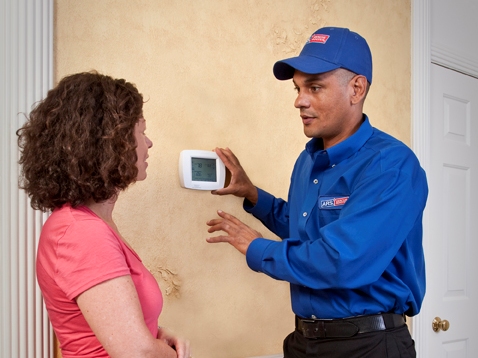

Did you just notice a low battery indicator displayed on your home's heating and cooling system thermostat? Many thermostats still use batteries, while others draw power from your home’s electrical or HVAC system.
It's a good idea to replace the thermostat battery on a set date every year. The start of autumn season is an excellent option. You should also replace the batteries in your carbon monoxide (CO) detectors.
If you've been away for an extended length of time, or never if you're just moving into your house for the first time, it's definitely past due to learn how to change the batteries in your thermostat. We'll guide you through the easy steps of replacing your thermostat's batteries in this article.
When your thermostat tells you the batteries are about to die, it's time for some new ones. Almost all programmable models have a low battery indicator appears, usually around a month or two before the battery runs out entirely. It might be a flashing light, a battery symbol, or text stating the warning; what matters is that you do not ignore it.
Because, after all, humans procrastinate. Your thermostat provides you with adequate warning before the batteries die. You'll know the batteries are totally out of power when your programmable thermostat's screen is totally blank.
A dial, switch, digital or programmable thermostat with a battery will require normal AA or AAA alkaline batteries, a button-style 3V lithium battery, or a 9-volt battery.
Check your owner's manual for the right batteries, and if you need lithium, double-check that you read and note the size carefully. It's always a good idea to have backups on hand, although it's best to change the batteries once a year.
Batteries have a lifespan of 5 years or more, while others may only survive three months. Even if your thermostat is permanently connected, it will most likely have a back-up battery that must be changed on a regular basis.
This backup battery allows your system to continue functioning even if the electricity grid goes down.
Gather any essential equipment, such as a flashlight and a flat-blade screwdriver , before getting started.
Remove the outer cover from the thermostat housing. If you can't do it, push it up and pull it off the wall mount plate.
Turn the thermostat cover over to see where you can insert new batteries. Dislodge the dead batteries by sliding a small flat end screwdriver into the openings and then lifting up carefully with your fingers.
After you've pruned the old batteries, insert the new ones with the positive terminal facing upwards into the slots. This is unless the thermostat cover itself contradicts this.
Simply match the plus and negative signs on the label with those on the battery itself.
When replacing the batteries, make sure the thermostat cover is reattached to the wall plate. The little posts on the back should be aligned with the terminal screw block. Slide the cover down until it clicks into place.
If you have a thermostat that was made of mercury, handle it with care. Mercury is a severe neurotoxin and should be handled or disposed of in a safe manner. In fact, if you're looking to save money on your energy bills, consider buying an energy-saving programmable thermostat.
Even if your thermostat is old, it may still function for a while. However, if the device isn't working properly, or you keep having to replace the batteries frequently, you should replace the thermostat right away. The following are several of the indicators that your thermostat isn't operating correctly:
Many homeowners turn to new thermostat models today, like the Nest Learning Thermostat, receiving power directly from your heating and cooling systems. It also uses 2 AAA alkaline batteries as a backup, and not as the main power source if your system can't deliver enough power. This way you never have to constantly remember to change batteries every year.
If you think it's time to upgrade your thermostat or have a heating or cooling system issue, call the heating and air conditioning experts at ARS/Rescue Rooter. Our team of HVAC technicians are trained on all components of properly-functioning HVAC systems - including a home thermostat. For all of your air conditioning repair or heating repair needs, call us at 866-399-2885 or find your nearest ARS/Rescue Rooter location to schedule service today!